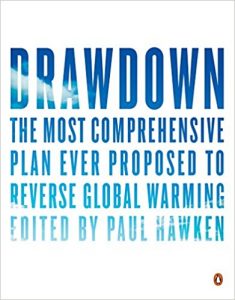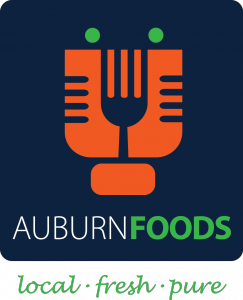 In the November 2017, Sustainability Digest I wrote about attending a conference in Atlanta and hearing Paul Hawken talk about Drawdown: The Most Comprehensive Plan Ever Proposed to Reverse Global Warming. Project Drawdown, for the first time, defines specifically what we need to do, and what we can do, to arrest and reverse global warming. The Drawdown project team of experts researched and analyzed hundreds of possible solutions and ranked the top 100 according to their ability to re-sequester carbon, to draw down greenhouse gas concentrations in the atmosphere. They did the math. They have the numbers.
In the November 2017, Sustainability Digest I wrote about attending a conference in Atlanta and hearing Paul Hawken talk about Drawdown: The Most Comprehensive Plan Ever Proposed to Reverse Global Warming. Project Drawdown, for the first time, defines specifically what we need to do, and what we can do, to arrest and reverse global warming. The Drawdown project team of experts researched and analyzed hundreds of possible solutions and ranked the top 100 according to their ability to re-sequester carbon, to draw down greenhouse gas concentrations in the atmosphere. They did the math. They have the numbers.
The results were surprising to all involved. After organizing the top 100 solutions in seven categories – Energy, Food, Women and Girls, Buildings and Cities, Land Use, Transport, and Materials – the data shows clearly that the number one cause and solution to arresting and reversing global warming is… food. No one expected that.
Unconvinced? This is how the book introduces the section on food:
Think of the causes of global warming, and fossil fuel energy probably comes to mind. Less conspicuous are the consequences of breakfast, lunch, and dinner. The food system is elaborate and complex; its requirements and impacts are extraordinary. Fossil fuels power tractors, fishing vessels, transport, processing, chemicals, packaging materials, refrigeration, supermarkets, and kitchens. Chemical fertilizers atomize into the air, forming the powerful greenhouse gas nitrous oxide. Our passion for meat involves over 60 billion land animals that require nearly half of all agricultural land for food and pasture. Livestock emissions, including carbon dioxide, nitrous oxide, and methane, are responsible for an estimated 18 to 20 percent of greenhouse gases annually, a source second only to fossil fuels. If you add to livestock all other food-related emissions – from farming to deforestation to food waste – what we eat turns out to be the number one cause of global warming.
The food chapter includes sixteen of the top 100 global warming solutions. The most effective and potent food-related solution? Eating a plant-rich diet. Transitioning to a plant-rich diet would create a stunning 66.11 gigatons (one gigaton = 1 million tons) reduction of CO2 by 2050! And this solution requires no technological fix or government action. This solution is in our hands every meal, every day.
Scholar and journalist Michael Pollan advocates: “Eat food, not too much, mostly plants.” In an essay titled “Why Bother?” Pollan writes that one of the best ways to eat a plant-rich diet is by cultivating vegetable gardens in our yards, and if this is not practical, by claiming plots in community gardens. He reminds us that growing food “is the original solar technology: calories produced by the means of photosynthesis.” Talk about fresh, local, and nutrient-rich food, it doesn’t get any better. Not to mention that we will know whether or not, or how much, our produce has been treated by herbicides, pesticides, and fungicides. And all those benefits for essentially the price of seeds and soil preparation, and a little sweat equity which happens to be good for us. Pollan says gardening teaches us that it is possible to “provide for ourselves without diminishing the world.”
There are lots of opportunities in our community to learn about and create vegetable gardens. To create your own, contact the Lee County Master Gardeners, managed by the Alabama Cooperative Extension System. You can even become a Master Gardener and learn about vegetable gardens and a lot more: lawn care, landscape design and management, herbs, composting, and more.
To participate in community gardens in the area, the Auburn University Community Garden, managed by Tiger Dining Services, is right here on campus. At the website you’ll find a link to the Community Garden Contract should you wish to have a plot.

Look for the Auburn Foods logo at locations around campus.
You can support local gardens and enjoy garden-fresh food on campus wherever you see the Auburn Foods logo for “food grown by the Auburn Family for the Auburn Family…food options that are produced right in our own backyard,” including fresh vegetables from local gardens.
Check out the Organic Garden Club located in the Kreher Ecology Preserve, 2222 North College Street, to learn organic gardening practices.
Opelika Grows (O Grows) is an innovative partnership between the Auburn University College of Education, Opelika City Schools, Keep Opelika Beautiful, the Food Bank of East Alabama, and several corporate sponsors. O Grows creates school gardens, operates a community garden (lease a plot), employs students, and provides fresh vegetables for people in the community.
As with any truly sustainable solution, growing vegetables generates benefits across a spectrum of impacts. Gardening is a vehicle for essential physical activity, and physical activity that really pays off. Your garden can produce a variety of foods that are safe, inexpensive, conveniently nearby, nutrient-rich, as fresh as possible, and remarkably delicious. The extra bounty that inevitably results can be shared with friends and neighbors. And by growing and eating a plant-rich diet we can all be part of the most significant food-related initiative we can implement to reverse global warming.
“Power (in this case, in the form of nutritious, health-giving calories) to the people!”





Well, the Lee County Master Gardeners Association (LCMGA) would gratefully welcome interested green-thumb wannabes. Great suggestion Mike.